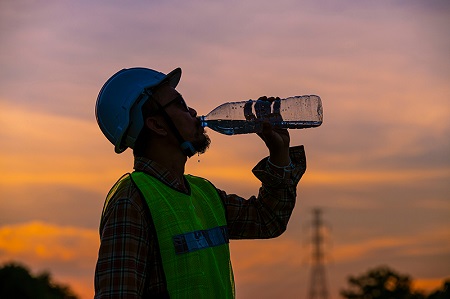Five Texans died of work-related heat illnesses in 2018, according to the Bureau of Labor Statistics. Another 270 Texas employees–nearly half of whom worked in construction or excavation–reported job-related heat ailments that required them to take time away from work. With proper training and education, heat-related illness and death are preventable. As part of a regular employee safety training program, include the following heat-related illness prevention tips:

1Stay hydrated
Provide workers with enough water and encourage them to drink at least one pint every hour. Avoid liquids that can dehydrate the body, such as caffeine. Consider carrying frozen water bottles to ensure cool hydration is available later in the shift.
2Modify work schedules
Monitor the temperature throughout the day and modify work schedules to limit strenuous activity during peak hours of heat-11 a.m. to 4 p.m. Allow for frequent rest with water breaks in shaded or air-conditioned areas. Firefighters and hazardous waste workers should remove gear and take regular cooldown breaks.
3Avoid clothing that traps heat
Avoid clothing that traps heat. Waterproof or impermeable clothing and wet or sweat-soaked clothing can trap heat. Avoid wearing rain-resistant or emergency protective gear longer than necessary. Layer a work shirt over an undershirt to help keep sweat and heat away from the skin. Choose lightweight, light-colored, loose-fitting clothing, if possible. Carry spare shirts to replace wet or sweaty shirts as needed.
4Wear gear that cools you
Consider wearing wet neck towels, gel-filled cooling neck scarves, or cooling vests to keep body heat down. Several types of cooling vests are available.
5Modify the environment
If it is impractical to air condition a hot indoor space, consider air conditioning a break room where workers can cool down. Consider portable air conditioning units to cool down individual workstations.
6Modify body functions
Monitor how heat affects the body by checking the color of your urine – dark yellow means it is time to hydrate. Outside workers and those in hot quarters expect to sweat in the heat, but decreased sweating can also mean dehydration.
7Slowly acclimate new or returning workers to the heat
New or returning workers need time to adapt to working in the heat. Gradually increase workloads and allow more frequent breaks.
8Know the signs of heat illness
Feeling dizzy or sluggish on a hot day can be the body’s way of signaling a more serious condition. For more information on heat cramps, heat exhaustion, heat stroke, and other work-related summer hazards download DWC’s free publication, Summer Safety Tips for Workers.
